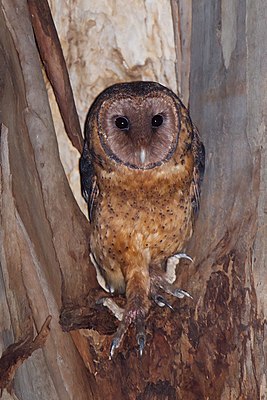Tasmania Barn Owl
| Tasmania Barn Owl | ||||||||||||
|---|---|---|---|---|---|---|---|---|---|---|---|---|

Tasmanian Barn Owl ( Tyto castanops ) |
||||||||||||
| Systematics | ||||||||||||
|
||||||||||||
| Scientific name | ||||||||||||
| Tyto castanops | ||||||||||||
| ( Gould , 1837) |
The Tasmanian barn owl ( Tyto castanops ) is a species from the genus of barn owls that occurs naturally only on Tasmania and Maria Island . It was introduced on Lord Howe Island . It is classified by some authors as a subspecies of the New Holland owl; However, other authors see it as an independent species due to the size and coloration of the New Holland Owl.
features
The Tasmanian barn owl is the largest species in its genus. It reaches a body length of 47 to 55 centimeters and weighs between 600 and 1,200 grams. The upper side of the body is predominantly gray-brown with white and black spots. The face veil is pale maroon to brown-yellow with a darker, in some individuals almost black region from the eyes to the base of the beak. The species has noticeable black spots on the underside of the body. The New Holland Owl is similar to the Tasmanian Barn Owl, but is smaller and noticeably paler with a paler facial veil.
The Tasmanian barn owl is considered to be a resident bird that predominantly populates forest and semi-open terrain with trees or bushes. The Tasmanian barn owl's way of life is essentially the same as that of the New Holland owl. Their food spectrum includes smaller mammals up to the size of a rabbit. It also beats smaller birds and lizards. It usually breeds in tree hollows. The clutch consists of two to four white eggs. Only the female breeds.
supporting documents
Single receipts
literature
- Claus König , Friedhelm Weick: Owls of the World . Christopher Helm, London 2008, ISBN 978-0-7136-6548-2